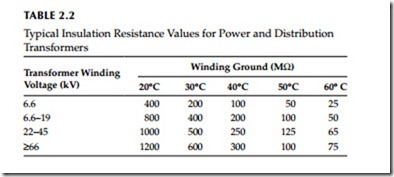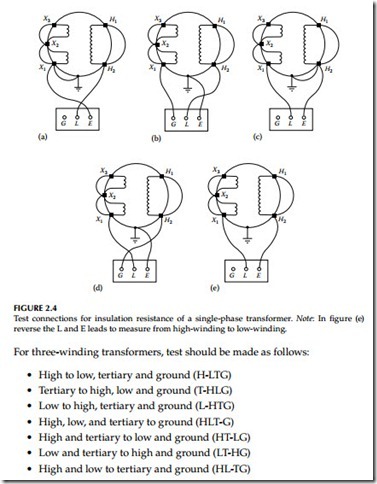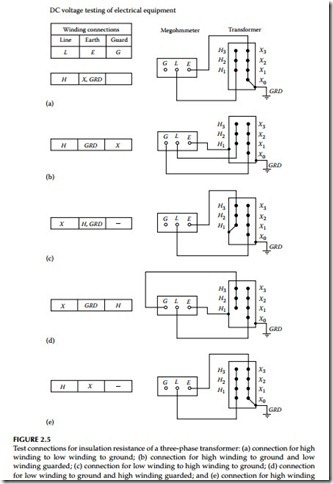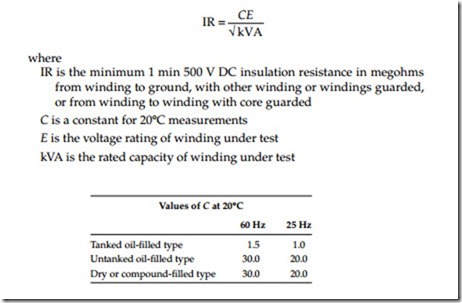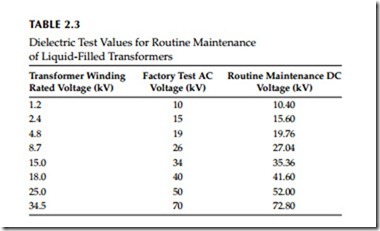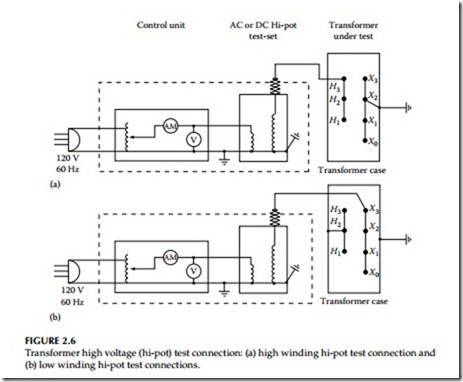Transformers
The DC testing of transformers involves testing of the solid winding insulation and the insulating fluids used in transformers. The testing of insulating fluids is covered in Chapter 4. The testing of solid winding insulation complements other transformer testing. The solid winding insulation tests are not conclusive in themselves, but provide valuable information on winding conditions, such as moisture content, and carbonization. The DC tests are con- sidered nondestructive even though at times they may cause a winding fail- ure. It should be pointed out that a winding failure results from an incipient failure that the test was supposed to detect. If it had gone undetected, it might have occurred at an unplanned time. The DC tests conducted for transformer winding insulation are discussed in the following section.
Insulation Resistance Measurement
This test is performed at or above rated voltage to determine if there are low resistance paths to ground or between winding to winding as a result of winding insulation deterioration. The test measurement values are affected by variables such as temperature, humidity, test voltage, and size of trans- former. This test should be conducted before and after repair or when main- tenance is performed. The test data should be recorded for future comparative purposes. The test values should be normalized to 20°C for comparison pur- poses. The general rule of thumb that is used for acceptable values for safe
energization is 1 MΩ per 1000 V of applied test voltage plus 1 MΩ. Sample resistance values of good insulation systems are shown in Table 2.2. The test procedures are as follows:
1. Do not disconnect the ground connection to the transformer tank and core. Make sure that the transformer tank and core are grounded.
2. Disconnect all high-voltage, low-voltage, and neutral connections, lightning arresters, fan systems, meters, or any low-voltage control systems that are connected to the transformer winding.
3. Before beginning the test, jumper together all high-voltage bush- ings, making sure that the jumpers are clear of all metal and grounded parts. Also jumper together all low-voltage and neutral bushings, making sure jumpers are clear of all metal and grounded parts.
4. Use a megohmmeter with a minimum scale of 20,000 MΩ.
5. Resistance measurements are then made between each set of wind- ings and ground. The windings that are to be measured must have its ground removed in order to measure its insulation resistance.
6. Megohmmeter reading should be maintained for a period of 1 min.
Make the following readings for two-winding transformers:
a. High-voltage winding to low-voltage winding and to ground
b. High-voltage winding to ground
c. Low-voltage winding to high-voltage winding and to ground
d. Low-voltage winding to ground
e. High-voltage winding to low-voltage winding
The connections for these tests are shown in Figures 2.4a through e and 2.5a through e for single-phase and three-phase transformers, respectively.
Megohmmeter readings should be recorded along with the test temperature (°C). The readings should be corrected to 20°C by the correction factors shown in Table 2.1. If the corrected field test values are one-half or more of
the factory insulation readings or 1000 MΩ, whichever is less, the transformer insulation system is considered safe for a hi-pot test.
Do not make the megohm test of the transformer winding without the trans- former liquid because the values of insulation resistance in air will be much less than in the liquid. Also, do not make the insulation resistance test of the transformer when it is under vacuum because of the possibility of flashover to ground.
The test connections shown in Figure 2.5a, c, and e are most frequently used. The test connections in Figure 2.5b and d give more precise results. The readings obtained in the connections in Figure 2.5a and b are practically equal to readings in test connections in Figure 2.5c and d, respectively.
Test connections for insulation resistance of a three-phase transformer: (a) connection for high winding to low winding to ground; (b) connection for high winding to ground and low winding guarded; (c) connection for low winding to high winding to ground; (d) connection for low winding to ground and high winding guarded; and (e) connection for high winding to low winding.
Acceptable insulation resistance values for dry and compound-filled transformers should be comparable to those for Class A rotating machinery, although no standard minimum values are available.
Oil-filled transformers or voltage regulators present a special problem in that the condition of the oil has a marked influence on the insulation resis- tance of the windings.
In the absence of more reliable data the following formula is suggested:
This formula is intended for single-phase transformers. If the transformers under test is one of the three-phase type, and the three individual windings are being tested as one, then E is the voltage rating of one of the single-phase windings (phase to phase for delta connected units and phase to neutral or star connected units) kVA is the rated capacity of the completed three-phase winding under test
Dielectric Absorption Test
The dielectric absorption test is an extension of the transformer winding insulation resistance measurement test. The test consists of applying voltage for 10 min and taking readings of resistance measurements at 1 min intervals. The resistance values measured during this test are plotted on log–log paper with coordinates of resistance versus time. The slope of the curve for a good insulation system is a straight line increasing with respect to time, whereas a poor insulation system will have a curve that flattens out with respect to time. There are two tests that are conducted under dielectric absorption test. These are PI and DAR tests, which are discussed in Section 2.3.
The DC hi-pot test is applied at above the rated voltage of a transformer to evaluate the condition of winding insulation. The DC high-voltage test is not recommended on power transformers above 34.5 kV; instead the AC hi-pot test should be used. Generally, for routine maintenance of transformers, this test is not employed because of the possibility of damage to the winding insulation. However, this test is made for acceptance and after repair of trans- formers. If the hi-pot test is to be conducted for routine maintenance, the AC test values should not exceed 65% of factory AC test value. The routine main- tenance AC voltage value should be converted to an equivalent DC voltage value by multiplying it by 1.6, that is, 1.6 times the AC value for periodic test- ing (i.e., 1.6 × 65 = 104% of AC factory test value). The DC hi-pot test can be applied as a step-voltage test where readings of leakage current are taken for each step. If excessive leakage current is noticed, voltage can be backed off before further damage takes place. For this reason, the DC hi-pot test is con- sidered to be a nondestructive test. Some companies conduct the AC hi-pot test at rated voltage for 3 min for periodic testing instead of the 65% of factory test voltage. The hi-pot test values for DC voltages are shown in Table 2.3.
The procedure for conducting this test is as follows (refer to Figure 2.6a and b for test connections):
• Transformer must have passed the insulation resistance test imme- diately prior to starting this test.
• Make sure transformer case and core are grounded.
• Disconnect all high-voltage, low-voltage, and neutral connections, low-voltage control systems, fan systems, and meters connected to the transformer winding and core.
• Short-circuit with jumpers together all high-voltage bushings and all low-voltage bushings to ground as discussed under “Insulation resistance measurements.”
• Connect hi-pot test set between high-voltage winding and ground.
Gradually increase test voltage to the desired value. Allow test voltage duration of 1 min, after which gradually decrease voltage to zero.
• Remove low-voltage to ground jumper and connect hi-pot test set between low-voltage winding and ground. Also connect the short- circuited high-voltage winding to ground. Gradually increase test voltage to desired value. Allow the test voltage duration of 1 min, after which gradually decrease voltage to zero.
• If the preceding two tests do not produce breakdowns or failures, the transformer is considered satisfactory and can be energized.
• Remove all jumpers and reconnect primary and secondary connections and other system equipment that may have been disconnected.
The following are some cautions and considerations in performing hi-pot tests:
In liquid-filled transformers two insulation systems are in series, that is, solid insulation with oil or synthetic fluid. When AC or DC hi-pot test voltage is applied, the voltage drops are distributed as follows:
When using DC hi-pot test voltage on liquid-filled transformers, the solid insulation may be overstressed.
Insulation that may be weakened near the neutral may remain in service due to lower stress under operating conditions. However, when subjected to hi-pot test voltage, it may break down and require immediate repair. The weakened insulation may usually be detected by the measurement at lower voltages.
If a hi-pot test is to be conducted for routine maintenance, consider the following in advance: (1) assume that a breakdown will occur, (2) have replacement or parts on hand, (3) have personnel available to perform work, and (4) is the loss of the transformer until repairs are made beyond the original routine outage?
